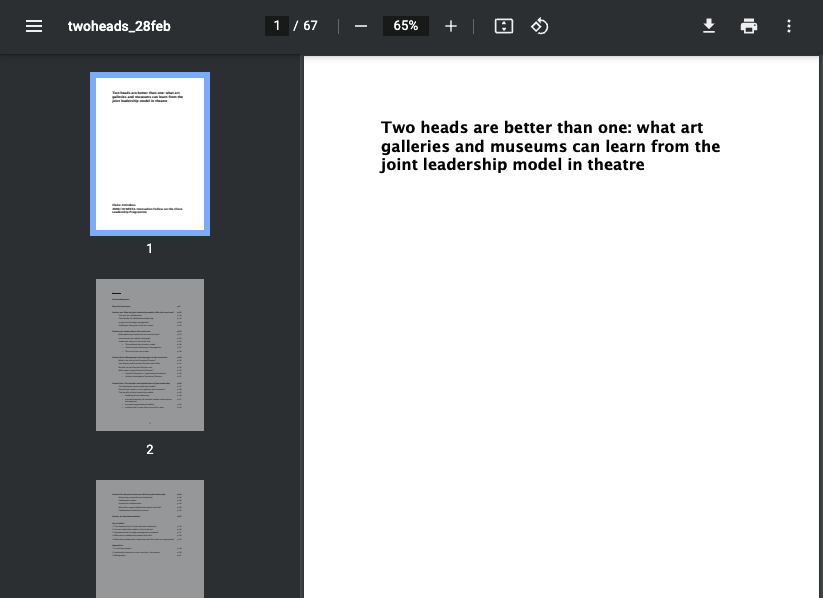Co-leadership: a research report
Ten years ago I undertook a research project as part of my Clore Fellowship, to explore how the model of joint leadership by joint Artistic and Executive Directors worked. I conducted many interviews with experienced ADs and EDs to understand how these roles worked together, what competencies were needed to make the model work well; the benefits and risks of having co-leaders and how Boards could recruit into these roles. It was a fascinating project and I was fortunate to speak to many inspiring senior figures who generously shared their experiences of making co-leadership work.
Recently I was contacted by an academic who is publishing a far more extensive survey of the topic, and this prompted me to re-read that report and reflect on how much has changed in the past decade.
At the time my interest was both professional and personal. I had been struggling for years the find the right role for myself in galleries and museums, having stepped out of curatorship earlier in my career. In those days curating was the only route into leadership roles in galleries. I also had a young family and was finding the prospect of a solo leadership role intimidating.
Via the research I concluded the co-leadership model works well for complex organisations where a wide range of skills are needed at a senior level: like theatres or art galleries. In those organisations where leaders might, at times, need to work closely with artists on projects or in the rehearsal room or travel extensively for work, having a joint leadership model enabled the capacity for this to happen. Also in a volatile world, having a ‘sounding board’ with whom to develop ideas and share challenges was another advantage. And when it was time for one of the co-leaders to transition to another post, having a joint leadership model offered stability. So I concluded ‘two heads are better than one’; so long as people appointed had the competencies needed to collaborate well, and accountability and values were shared.
When I first published this report I suggested that art galleries and museums might do well to consider a co-leadership model, and indeed quite a few did. Tate had already pioneered the joint leadership mode in Liverpool (from 2006) and St Ives (from 2007). Other galleries and museums began to adopt an AD/ED model during the years that followed my report.
Looking back at this report now, with the benefit of another decade of experience of organisational and leadership development behind me I’d frame my recommendations slightly differently. But I would not change the core thesis: that collaborative leadership has many benefits and that to work well joint leadership needs careful design and leaders with collaborative values and skillsets.
There are two things I would change however:
Firstly, I no longer think that the AD/ED model is necessarily the optimum model for art galleries/museums. I still very much believe in collaborative leadership styles and shared responsibility, but that could be achieved via a CEO-led organisation with a senior management team, or a co-directorship with 2-3 leaders. Personally I like collaborating with people as equals, but other models can work. This was very much the view of one of my interviewees at the time – Caroline Collier – who advised me that a collaborative style was more important than a structure where two leaders were equals.
Wider studies of this form of pluralist leadership find the co-leadership structure is often introduced in sectors or organisations where multiple interests, which may be in tension, need to be afforded equal importance in strategy. Initially some of the rationale for having more ED-types in the galleries sector was to counter-balance an overly artistic centred model of leadership which overlooked these wider concerns. 10-15 years ago we needed the structural reinforcement for an audience champion at the ‘top’ of galleries and art museums, today I feel this is less necessary. We are seeing a new generation of artistic leaders in the visual arts sector moving into key roles who have a broader civic, educational or social vision for their organisations.
Secondly, I would make a far stronger case for co-leadership as a practical solution to CEO roles becoming impractical and overwhelming far. Co-leadership offers a more inclusive model for those with caring responsibilities or health issues/ disabilities. I felt this strongly at the time but hesitated to articulate that view for fear it would be perceived as my personal agenda.
Re-reading the report what strikes me as still very relevant is the question of what systems, structures, skills and values enable collaborative leadership to work. This is the ‘work’ that I continue to grapple with when supporting leaders as a coach, or teams and organisations as an organisational development consultant. How do we work together is a way that makes the best of all our talents and energy, and which – through collaboration – enables us to create things which go far beyond a sum of their parts.
But it also strikes me that in embracing collaborative leadership we have the opportunity to re-shape leadership roles that will contribute to ensuring our senior staff better represent our wider society in terms of gender, disability and caring responsibilities.

Recent Comments